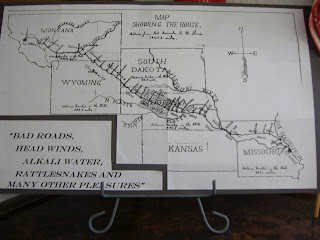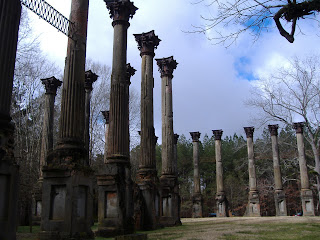Delivery to Gillette, WY
On a hot, humid, sunny June day we picked up a Winnebago Sightseer in Forest City and headed west past very wet fields. Water is sitting in ditches and low areas in the fields after our steady rains the last few weeks. Farmers were working ground around the wet spots to get the crop in.
Traffic on Interstate 90 us light compared to Interstate 80 which is our usual route. Windmills are scattered all over this area of Minnesota. Southwest Minnesota was described as a "sea of grass" by the early Prairie Schooner travelers headed west!
In and out of clouds and sunshine as we cross into South Dakota. Past Sculpture Park with the world's largest bull's head. From flat farm land into rolling hills covered with grass. Herds of cattle grazing in tall grass with their calves nearly hidden. Large blue ponds of water reflecting the blue sky. Hay being baled. The silhouette of grain elevators in the distance with rail road cars parked for loading.
Past the exit to De Smet, which is one of the homes of Laura Ingalls Wilder. Our daughter and several granddaughters would love to spend some time there!
Listening to Lee Kline's Iowa Notebook getting a chuckle and a remember when as we put on miles. Also Providential Battles by William Potter who provides a providential interpretation of twenty of the greatest military battles in the world.
The highway runs along the bank of the Missouri River. Lewis and Clark traveled here. The Rest Area with scenic overlook is a great place to stop and stretch and learn some history of the area.
Across the river and climbing the hills that will lead into Wyoming. Passing signs advertising all the "tourist" stops available. We counted at least 100 antique fire engines beside that many signs for the Fire House Brewery!!
Acres of farmland spread out over the rolling hills. Some were being planted. Rows of trees planted as windbreaks looked like someone making pencil lines on a quilt of brown and greens. Ranchers on horseback herding cattle. A semi-flatbed with rolls of wire parked along the gravel road near where ranchers were making fence. An ATV was used to move the rolls of wire. We can see the edge of the Badlands from the highway.
Big blue/black clouds never dropped rain all afternoon as we drove under and around them until about 10 PM! The wind and hard rain rocked us to sleep that night!
A hazy, cloudy morning with a blanket of fog of the pine tree covered hills transition into rocky grass covered hills, wide valleys and mountain tops on the horizon as we cross into "Big Sky" Wyoming. Areas of blue sky are allowing the sun rays to highlight the buttes and low mountains ahead. What a contrast! The palette of greens is changing from lush deep greens to a lighter shade due to dryness of the area.
Through the windshield:
- Small groups of antelope grazing.
- Herds of black Angus cattle grazing.
- Small ranches scattered through the valleys with exits to "Ranch Roads."
- Trees lining the meandering creeks.
- Rows of wooden snow-fences stand at attention holding the line prepared for the snowy battle to start.
- Oil wells scattered along the valley.
- Long trains with coal filled cars.
- Mining machinery sitting in lots along the highway.
- Storage tanks scattered between oil wells.
- A coal mine with conveyors to power plant. The gully dug deep showing the black vein of coal to be mined and loaded on the conveyors.
- Iris and lilacs are just blooming in the yards of Gillette.
Took exit 153 to go to the Devil's Tower, but stopped in the town of Moorecraft and visited the West Texas Trail Museum.
History: In 1866, the first herds of longhorn cattle were trailed from Texas through Wyoming and into Montana, a 1700 mile journey. At its peak in 1844 it was estimated that 800,000 cattle were coming north past the dry areas in the south. The Belle Fourche River was a welcome sight. The last major stop before being driven further north.
In 1887 Jacob Kaufman saw his chance to make some money off the weary cowboys by operating a store/saloon at this stop. It served as a stage stop and post office for a mail run between Buffalo, WY and Spearfish, SD. The inspector for the post office didn't like how the mail was being handled and moved the office to the AK Ranch. Stocks Miller ran this office and named it Moorcroft after his home town in Scotland!
The CB&Q Railroad laid its tracks east of this spot in 1891 following the Texas Trail route and had Moorcroft as its northernmost point. This was perfect for laarge ranches to ship cattle via the railroad.
Museum Facts and Highlights:
- For a perspective: In 1894 there were 32 trail herds each with 4,000 head. Each herd stretched 2 miles long and 1/2 mile wide.
- In 1866 Mr. Nelson bought 600 cattle for $10 each, drove them 1500 miles north on the trail and sold them for $100 each!
- The Texas Longhorn originated in South Texas as a cross between cattle brought from Spain and cattle from the European/American settlers. The are known for their long horns and hardiness in the harsh weather conditions. Their long and lean structure allowed them great stamina for traveling the trails.
- The demand for more cattle was the result of more settlers, explorers, entrepreneurs and the killing of the bison.
- Branding was important to prove ownership of cattle. Branding was started in 1541 when Cortez brought animals to the New World from Spain. They were branded with 3 crosses. There are 3 ways to read a brand: from left to right, from top to bottom, and from outside to inside..
- A cowboy would have a pair of woolies--sheepskin chaps, hat, spurs, knife, branding irons, rope and quirt
- A shave and a haircut was six bits--75 cents!
- A 10 ft handles on a magnesium bakers peel that was used to insert and remove baked goods from an oven.
- An oak roll top desk ordered from Sears in 1814.
- Family histories of pioneers, collection of quilts & sewing machines.
- Railroad items and photographs from the CB&Q (Chicago Burlington & Quincy).
- Western saddles and tack.
- A complete cowhide.
- A display of the Empire Sheep Ranch owned by the Guthrie Family. They owned 20,000 acres and 55,000 sheep at a time when open range was dominated by the cattle industry. Yes, the display shows newspaper articles of cattlemen trying to run off the sheep herders! Remind you of the song about the cattlemen and the ranchers in "Oklahoma?" Mrs. Guthrie ran the ranch after her husbands death. After supper she would line up bottles on a fence, take her gun and practice her shooting. This would let all the men working for her that she was capable of handling a gun. It was rumored that she carried a lot of money in her big hand bag and a gun. Since she was often alone she had a gun near her at the ranch at all times. She was known as a shrewd and competent rancher.

- A map and information about the bicycle trip by soldiers from Missula, MT to St. Louis, MO. "On June 14, 1897 the Bicycle Corps of the Twenty Fifth Infantry USA left Missula, MT to determine if the bicycle could be used in warfare of the future! Other countries were adopting it as component parts of their armies," stated the newspaper article. You can watch a complete program on Montana PBS website!
Devil's Tower
Following the river north and east the highway curves through rocky ledges and pine forests with open grassland being grazed by flocks of sheep.
The tower rises up 865 feet. It is actually the exposed core of a volcano. The sides are made up of thousands of small columns. The rocks and boulders around the base that are broken pieces of columns having fallen from the sides.
In 1906 President Teddy Roosevelt designated Devil's Tower as the nations's first national monument. Today the park service has7.4 miles of walking paths and a visitors center.
Pender, Nebraska
Out of mountains and pastures and ranches and into rolling hills covered with irrigated hay corn & bean fields, cattle feeding lots, and hog confinement buildings. Nothing is flat! Even the irrigation rig curves with the hills. A sea of grass--as the wind blows it waves! Heading to Pender, Nebraska for an appointment at the Blue Ox factory to get our tow bar checked, cleaned and lubricated.
The town is pretty. Homes and business have outdoor quilt blocks with the quilt's name. Pretty flowers. Huge brick building on main street, Palace Hotel, has several small shops at street level. Nice city park.
This time our schedules did not work for a visit with son and family so---Back to the Prairie!
Thanks for traveling with us,
Prairie Schooners








